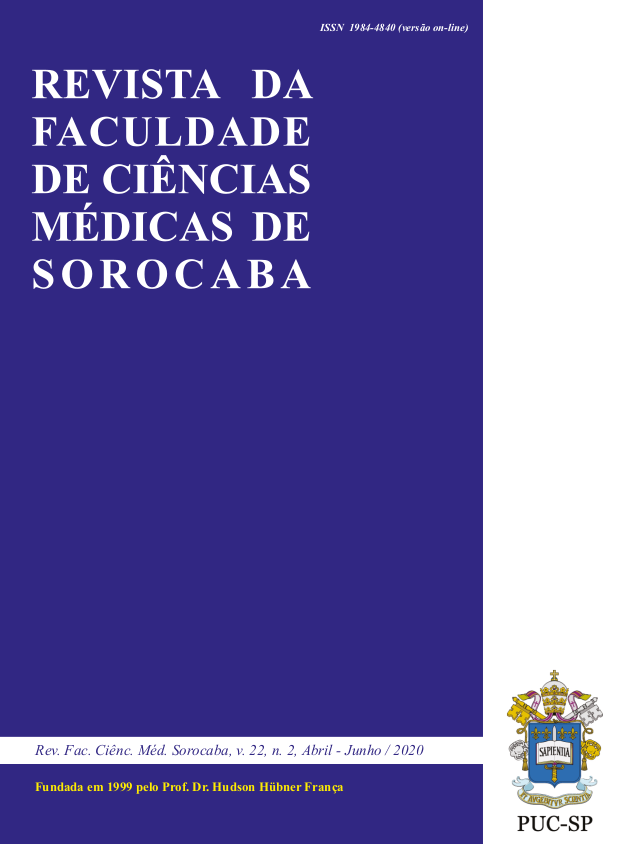Serum dosage of vitamin D in women during gynecologic control
DOI:
https://doi.org/10.23925/1984-4840.2020v22i2a7Keywords:
vitamin D, vitamin D deficiency, women’health, gynecology.Abstract
Introduction: Vitamin D is a necessary factor for the development and maintenance of bone tissue, and normal calcium and phosphorus homeostasis. We live in a time when vitamin D deficiency (VDD) can be considered an epidemic; knowing its levels in women is essential, considering the menstrual cycle and the arrival of menopause, which can determine serious complications. Methods: A total of 87 patients treated by the Barbacena School of Medicine was studied. All patients underwent vitamin D dosing; the chosen method was Elecsys Vitamin D. The results were compared with clinical, gynecological, and epidemiological aspects. Results: The average vitamin D was 31.18}13.25, and 17.45% of the patients had low or extremely low average vitamin D. There was no association between serum vitamin D dosage and age (p=0.3), number of pregnancies (p=0.4), number of deliveries (p=0.2), and abortions (p=0.14). There was no association with sun exposure, milk and dairy products consumption, or sunscreen use (p>0.05), but there was an association when comparing good milk consumption with non-milk consumption (p=0.03). Conclusions: Present data are important because they identify vitamin D deficiency in a considerable percentage of the adult female population.
References
Holick MF. Vitamin D deficiency. N Engl J Med. 2017;357:266–81. http://doi.org/10.1056/NEJMra070553
Dawodu A, Wagner CL. Prevention of vitamin D deficiency in mothers and infants worldwide - a paradigm shift. Paediatr Int Child Health. 2012;32:3-13. http://doi.org/10.1179/1465328111Y.0000000024
Chicote CC, Lorencio FG; Comité de Comunicación de la Sociedad Española de Bioquímica Clínica y Patología Molecular. Vitamina D: una perspectiva actual. Barcelona: Comité de Comunicación de la Sociedad Española de Bioquímica Clínica y Patología Molecular; 2013.
Institute of Medicine (US). Committee to Review Dietary Reference Intakes for Vitamin D and Calcium; Ross AC, Taylor CL, Yaktine AL, Del Valle HB. Overview of vitamin D. Washington: National Academies Press; 2011.
Aydogmus S, Kelekci S, Aydogmus H, Eriş S, Desdicioğlu R, Yilmaz B, et al. High prevalence of vitamin D deficiency among pregnant women in a Turkish population and impact on perinatal outcomes. J Matern Neonatal Med. 2015;28:1828–32. http://doi.org/10.3109/14767058.2014.969235
Holick MF. The vitamin D deficiency pandemic: Approaches for diagnosis, treatment and prevention. Rev Endocr Metab Disord. 2017 Jun;18(2):153-165. http://doi.org/10.1007/s11154-017-9424-1
Brasil. Sociedade Brasileira de Endocrinologia e Metabologia. Vitamina D novos valores de referência [Internet]. [acesso em 1 mar. 2019]. Disponível em: https://www.endocrino.org.br/vitamina-d-novos-valores-de-referencia/
Tous M, Villalobos M, Iglesias L, Fernandez-Barrés S, Arija V. Vitamin D status during pregnancy and offspring outcomes: a systematic review and meta-analysis of observational studies. Eur J Clin Nutr. 2020;74(1):36-53. http://doi.org/10.1038/s41430-018-0373-x. Epub 2019 Jan 25.
Perreault M, Moore CJ, Fusch G, Teo KK, Atkinson SA. Factors associated with serum 25-hydroxyvitamin D concentration in two cohorts of pregnant women in Southern Ontario, Canada. Nutrients. 2019;11(1):123. http://doi.org/10.3390/nu11010123
Ferreira PP, Cangussu L, Bueloni-Dias FN, Orsatti CL, Schmitt EB, Nahas-Neto J, et al. Vitamin D supplementation improves the metabolic syndrome risk profile in postmenopausal women. Climacteric. 2019;23(1):24-31. http://doi.org/10.1080/13697137.2019.1611761
Mitchell DM, Ruppert K, Udupa N, Bassir F, Darakananda K, Solomon DH, et al. Temporal increases in 25-hydroxyvitamin D in midlife women: Longitudinal results from the Study of Women's Health Across the Nation. Clin Endocrinol (Oxf). 2019;91(1):48-57. http://doi.org/10.1111/cen.13986
Holick MF, Binkley NC, Bischoff-Ferrari HA, Gordon CM, Hanley DA, Heaney RP, et al. Evaluation, treatment, and prevention of vitamin D deficiency: an Endocrine Society clinical practice guideline. J Clin Endocrinol Metab. 2011;96(7):1911-30. http://doi.org/10.1210/jc.2011-0385
Neale RE, Khan SR, Lucas RM, Waterhouse M, Whiteman DC, Olsen C. The effect of sunscreen on vitamin D: a review. Br J Dermatol. 2019;181(5):907-15. http://doi.org/10.1111/bjd.17980
Pittas AG, Dawson-Hughes B, Sheehan P, Ware JH, Knowler WC, Aroda VR, et al. Vitamin D supplementation and prevention of type 2 diabetes. N Engl J Med. 2019;381(6):520-30. http://doi.org/10.1056/NEJMoa1900906
Giorelli GV, Matos LN, Saado A, Soilbelman VL, Dias CB. No association between 25-hydroxyvitamin D levels and prediabetes in Brazilian patients. A cross-sectional study. Sao Paulo Med. J. 2015;133(2):73-7. https://doi.org/10.1590/1516-3180.2013.7180005
Qi D, Nie XL, Wu S, Cai J. Vitamin D and hypertension: Prospective study and meta-analysis. PLoS One. 2017;12(3):e0174298. http://doi.org/10.1371/journal.pone.0174298
Alagacone S, Verga E, Verdolini R, Saifullah SM. The association between vitamin D deficiency and the risk of resistant hypertension. Clin Exp Hypertens. 2019;42(2):177-80. doi: http://doi.org/10.1080/10641963.2019.1601204
Chen S, Sun Y, Agrawal DK. Vitamin D deficiency and essential hypertension. J Am Soc Hypertens. 2015;9(11):885-901. http://doi.org/10.1016/j.jash.2015.08.009
Pilz S1, Tomaschitz A, Ritz E, Pieber TR. Vitamin D status and arterial hypertension: a systematic review. Nat Rev Cardiol. 2009;6(10):621-30. http://doi.org/10.1038/nrcardio.2009.135
Ze'ev Hochberg, Irit Hochberg.Evolutionary Perspective in Rickets and Vitamin D. Front Endocrinol. 2019;10:36. http://doi.org/10.3389/fendo.2019.00306
Downloads
Published
How to Cite
License
Copyright (c) 2021 Revista da Faculdade de Ciências Médicas de Sorocaba

This work is licensed under a Creative Commons Attribution-NonCommercial 4.0 International License.
Os autores no momento da submissão transferem os direitos autorais, assim, os manuscritos publicados passam a ser propriedade da revista.
O conteúdo do periódico está licenciado sob uma Licença Creative Commons 4.0, esta licença permite o livre acesso imediato ao trabalho e que qualquer usuário leia, baixe, copie, distribua, imprima, pesquise ou vincule aos textos completos dos artigos, rastreando-os para indexação, passá-los como dados para o software, ou usá-los para qualquer outra finalidade legal.

 Este obra está licenciada com uma Licença
Este obra está licenciada com uma Licença 